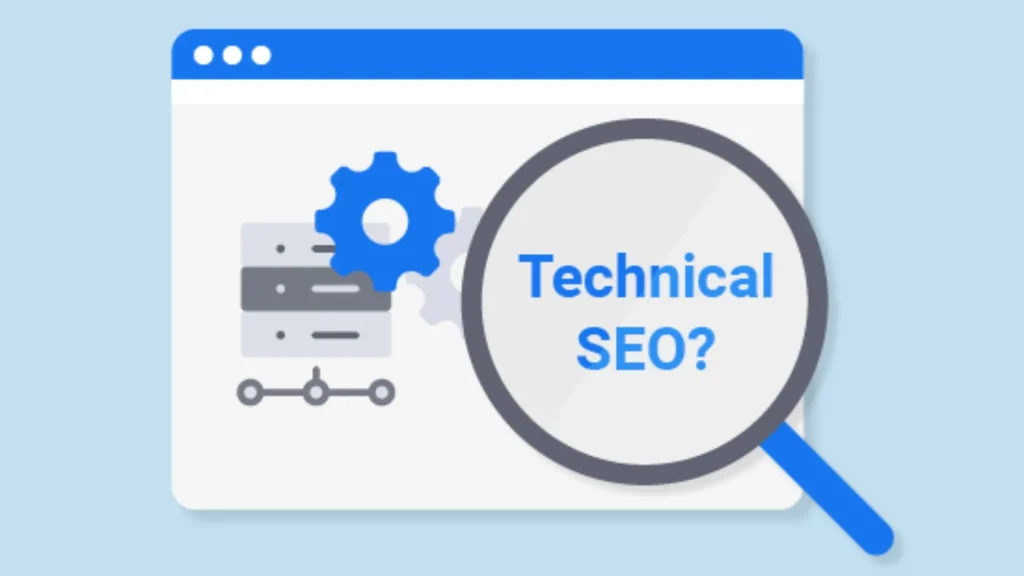Technical SEO is all about setting up your website so that search engines can easily find, read, and understand your content.
It focuses on the behind-the-scenes elements, like how fast your site loads, how mobile-friendly it is, and how smoothly search engines can move through your pages.
When done right, technical SEO makes your site faster, cleaner, and more trustworthy, both for search engines and for users.
And the result?
Better visibility in search results, more clicks, and more growth.
In this guide, we’ll walk you through the core parts of technical SEO and show you how to set up your website the right way.
So, why does technical SEO really matter?
Because speed, usability, and structure can make or break your site’s performance. For example, even a 1-second delay in page load time can reduce conversions by up to 7%, And it’s not just about conversions, 53% of mobile users will abandon a page if it takes longer than 3 seconds to load, as highlighted by Think with Google.
Google has also made it clear that page experience and Core Web Vitals play a role in rankings. This means your website’s speed, visual stability, and mobile responsiveness aren’t just good for users, they’re also essential for visibility in search results
Core Components of Technical SEO
Crawlability and Indexability: Helping Search Engines Find and Trust Your Site
To show up on Google, your content first needs to be seen and understood by search engines. That’s where crawlability and indexability come into play.
So, what’s the difference?
- Crawlability is all about access. Can search engine bots (like Googlebot) reach your pages and scan what’s inside?
- Indexability is about approval. After bots read your page, can it be saved to Google’s database and show up in search results?
Both are non-negotiable. If your page can’t be crawled, it’s invisible. If it can’t be indexed, it won’t rank, no matter how good your content is.
Here’s how the process works:
- Discovery: Google finds a link to your page, maybe through a sitemap or another website.
- Crawling: It sends a bot to visit and read your content.
- Rendering: The bot processes your layout and structure (especially important for JavaScript-heavy sites).
- Indexing: If all looks good, your page gets stored in Google’s massive index.
- Ranking: Your indexed page is now eligible to appear for relevant search queries.
A properly crawlable and indexable site lays the groundwork for all your SEO efforts. Without it, your best pages might never get seen.
Key things that affect crawlability and indexability:
- Internal linking: Ensuring important pages are linked from other parts of your site is critical. Internal linking helps search engines discover and access all relevant pages, preventing orphan pages that are not found during crawling
- XML Sitemap: Acts like a roadmap for Google, tell it which pages matter most.
- Robots.txt and Meta Tags: These control what search engines can crawl or index.
For example:- Disallow in robots.txt blocks crawling.
- noindex in meta tags blocks indexing.
- Crawl Budget: Google doesn’t crawl every page on large sites. So, your most important pages need to be easy to reach.
- Mobile-First Indexing: Google looks at your mobile version first. If your mobile site is broken, your content might not get indexed at all.
How to make your site easier for Google to understand:
- Make sure important pages are linked from other pages (no page should be an island).
- Keep your XML sitemap updated and submit it in Google Search Console.
- Don’t block important pages using robots.txt or noindex.
- Fix broken links and avoid sending bots in circles with too many redirects.
- Use clean HTML and include descriptive headings and relevant keywords naturally.
Crawlability and indexability are the first doors to better rankings. If those doors are locked, Google won’t even step in, and your content stays hidden.
Site Architecture and URL Structure: Build It Right So Google Doesn’t Get Lost
Ever visited a messy store where nothing is in place? Hard to find what you need, right? That’s what it feels like for search engines when your site structure is confusing.
Let’s fix that.
What is Site Architecture?
It’s simply how your website is organized, how pages are grouped, how they link to each other, and how easy it is to move from one section to another.
A clear structure helps both:
- Visitors (they find what they need faster), and
- Search engines (they understand what’s important and what connects to what)
Here’s why it matters:
- Google finds pages faster. If your pages are linked well, they won’t get “lost” on your site.
- It gives context. Linking related content together helps search engines see what your site is really about.
- It spreads ranking power. Pages with backlinks can pass authority to others through internal links.
- It helps users stay longer. Clean menus and logical navigation = better experience.
Best practices for a solid site structure:
- Flat architecture: Every page should be just 3 to 4 clicks away from the homepage.
- Group related content together: Like putting all your kitchen stuff in one cabinet, it just makes sense.
- No orphan pages: Every page should be reachable from somewhere on the site.
- Simple, clear menus: Your main navigation should be consistent across all pages.
- Breadcrumbs: Let users see where they are in the site journey.
- Sitemaps: Use both HTML for users and XML for search engines.
Now, let’s talk about URL Structure.
A good URL is like a good street name, clear, simple, and easy to follow.
What makes a good URL?
- Readable: Use actual words, not strings of numbers.
- ✅ /shoes/running
- ❌ /product?id=891287
- Hyphens over underscores: Like best-running-shoes, not best_running_shoes
- Lowercase letters only: Avoid weird technical issues
- Use keywords, naturally: If the page is about laptops, it’s okay to say so in the URL.
- Avoid unnecessary parameters: Things like ?sessionid=234abc just make URLs messy.
Google’s top suggestions:
- Use words your audience understands
- Avoid special characters, stick with standard words
- Keep URLs short and descriptive
A well-structured site and clean URLs don’t just help SEO, they help your visitors trust and explore your brand. And when users stick around, Google takes notice.
Mobile Optimization: Because Your Users Aren’t on Desktops Anymore
Let’s face it, people don’t browse websites sitting at desks anymore. They scroll, tap, and buy while on the move. And if your site doesn’t work well on a mobile device, you’re losing traffic, rankings, and money.
That’s where mobile optimization comes in.
Why it really matters:
- Most of your visitors are mobile Statista reports that up to 59.45% of web traffic now comes from smartphones.
- Google uses your mobile site for ranking. With mobile-first indexing, Google mainly looks at the mobile version of your site when deciding where to rank you.
- User experience is everything. If your mobile site is slow, hard to tap through, or cluttered, people bounce. And when they bounce, rankings drop.
- Conversions take a hit too. Mobile users shop fast, slow load times or tiny buttons lead to abandoned carts and missed leads.
- Local SEO depends on mobile. Most local searches happen on phones. If you’re a service or local business, this is non-negotiable.
Key practices to keep your site mobile-ready:
- Responsive Design: Your website should automatically adjust to fit any screen, big or small. No zooming. No horizontal scrolling.
- Fast Loading Times: Compress images, reduce unnecessary scripts, and keep the layout light.
Easy Navigation: Use large buttons, clear menus, and avoid overcrowded layouts. - Mobile-First Testing: Always check how your site looks and works on phones, not just desktops.
If your mobile experience is clunky, your SEO performance will suffer, no matter how great your content or keywords are.
Site Speed and Performance: Because No One Likes a Slow Website
You’ve got great content. A stunning design. But if your site loads like it’s stuck in 2008, people won’t stick around, and neither will Google.
In today’s SEO world, speed isn’t a luxury, it’s a requirement.
Why it matters:
- Users leave slow sites. A delay of just 1 second can drop conversions by 7%.
- Google uses speed to rank. The faster your site loads, the better your chances of ranking.
- Core Web Vitals are now a ranking factor. These metrics tell Google how smooth your site feels to real users.
Focus on these key performance signals:
- Largest Contentful Paint (LCP): How fast the biggest piece of content (like a banner or image) loads.
- Cumulative Layout Shift (CLS): Measures how much stuff jumps around while the page is loading.
- Interaction to Next Paint (INP): Tracks how quickly users can interact with your page after clicking or tapping.
Easy wins to improve your site’s speed:
- Compress and optimize images: Use tools like TinyPNG, WebP format, and lazy loading, so images load only when needed.
- Minify your code: Shrink your CSS, JavaScript, and HTML files to load them faster.
- Use browser caching: Save static files (like logos and stylesheets) in a user’s browser, so they don’t have to reload them on every visit.
- Reduce unnecessary scripts: Limit plugins and external tracking scripts that slow things down.
- Use a CDN: A Content Delivery Network serves your site from multiple global locations, reducing wait time for users far from your server.
- Prioritize what loads first: Make sure the content at the top of your page loads quickly, that’s what users see first.
Tools to track and improve speed:
Check your site regularly and make improvements, even small fixes can make a noticeable difference.
Secure Sockets Layer (SSL): Build Trust with a Padlock
Ever noticed that tiny padlock next to a website URL? That’s not just decoration, it tells you the site is secure.
That’s where SSL comes in. It’s what turns HTTP into HTTPS and protects the data that moves between your site and your visitors.
Why SSL matters for SEO and trust:
- It keeps data safe. SSL encrypts things like login info, payment details, and contact forms so that hackers can’t steal them.
- It proves your website is legit. An SSL certificate confirms your identity, users know they’re dealing with the real you, not a scam site.
- Google likes it. HTTPS is a confirmed ranking factor, which means it can help your site appear higher in search results.
- Browsers warn users if you don’t have it. Chrome and other browsers show a “Not Secure” warning for HTTP sites, and that’s a trust killer.
How to Do It: Securing Your Site with SSL
- Install an SSL certificate on your website domain. Most hosting providers offer a free SSL, just activate it through your dashboard.
- Update all internal links from HTTP to HTTPS so you don’t lose traffic or trigger unnecessary redirects.
- Redirect old HTTP URLs to their secure HTTPS versions using 301 redirects, this tells Google the switch is permanent.
Keep your SSL certificate renewed. An expired certificate can break trust, block access, or even show security warnings.
Advanced Technical SEO Elements (How to Do It)
1. Structured Data and Schema Markup: Help Google Understand Your Content
Structured data is like giving search engines a cheat sheet, it tells them exactly what your page is about. This helps your content appear with rich results like stars, product details, FAQs, and more.
Why it matters:
- Boosts click-through rates with rich snippets.
- Gives your content context, helping Google rank it more accurately.
- Supports features like breadcrumbs, sitelinks, and more.
How to do it:
- Use JSON-LD format (Google’s preferred method).
- Add relevant schema types based on page content (like Article, Product, FAQ).
- Use the Rich Results Test to check for errors.
Stick to the Schema.org vocabulary for best compatibility.
2. Pagination vs. Infinite Scroll: Which One’s Better for SEO?
If your website has lots of content, like blog posts, product listings, or news updates, you need to help search engines access all of it.
Pagination (SEO-friendly):
- Splits content into numbered pages: /page/1/, /page/2/
- Easier for Google to crawl and index.
- Uses rel=”next” and rel=”prev” tags to show the sequence.
Infinite Scroll (UX-friendly, SEO-tricky):
- Loads content as users scroll (like Instagram or Pinterest).
- Can hide content from search engines if not done right.
SEO Tip:
If you’re using infinite scroll, always provide paginated fallback pages behind the scenes, so bots can crawl everything.
3. International SEO with Hreflang Tags: Speak the Right Language
If your site serves different countries or languages, hreflang tags tell Google which version to show based on the visitor’s location and language.
Why it’s important:
- Avoids duplicate content across similar pages in different languages.
- Helps users land on the most relevant version of your site.
- Improves international search visibility.
How to do it:
- Add hreflang attributes in the <head> or via your XML sitemap.
- Use correct language–region codes (like en-us, fr-ca, es-mx).
Include an x-default tag for global audiences.
Technical SEO Audit: How to Do It Right
Even if your site looks good on the surface, technical issues under the hood can block search engines and frustrate users. That’s why regular audits are a must.
A technical SEO audit checks everything from site speed to crawl errors, helping you catch problems early and fix what’s holding your rankings back.
Must-Have Tools for a Solid Audit
You don’t need every tool out there. Just focus on the ones that get results:
- Google Search Console: Free, straight from Google. Use it to spot indexing issues, crawl errors, Core Web Vitals, and submit your sitemap.
- Google Analytics: Track how users behave on your site and where they drop off, this can signal technical friction.
- Screaming Frog: Crawls your site like Google does. Great for finding broken links, missing tags, duplicate content, and redirects.
- Semrush or Ahrefs: Powerful all-in-one SEO tools. Their site audit features catch deep issues and track your fixes over time.
- PageSpeed Insights: Analyze load time and Core Web Vitals. Shows exactly what’s slowing you down and how to fix it.
How to Run a Smart SEO Audit (Key Checklist)
- Crawl your entire site
Use tools like Screaming Frog or Semrush to scan for:- Broken links
- Missing title/meta tags
- Duplicate pages
- Redirect chains
- Check crawlability and indexing
In Google Search Console:- Are all important pages indexed?
- Is anything blocked in robots.txt or meta noindex?
- Test site speed and performance
Use PageSpeed Insights or Lighthouse to fix:- Slow server response
- Heavy images
- Render-blocking scripts
- Validate mobile usability
Your site should:- Work smoothly on all screen sizes
- Pass Google’s mobile usability test
- Inspect internal linking and architecture
Make sure:- No pages are “orphaned” (unlinked)
- Structure is flat (3–4 clicks max from homepage)
- Verify HTTPS and SSL
- Ensure all pages use HTTPS
- No mixed content warnings
- Review structured data
Use the Rich Results Test to:- Validate your schema
- Confirm eligibility for rich snippets
- Check for duplicate content
- Identify and resolve duplicates
- Use canonical tags to consolidate signals
- Look for manual actions and security issues
In Search Console:- Check the “Security & Manual Actions” section regularly
- Update your sitemap and robots.txt
- Ensure your XML sitemap is complete and submitted
- Robots.txt shouldn’t block important content
A technical audit is not just a one-time task, it’s something you should do quarterly or any time you launch, redesign, or update your site.
The Interplay Between Technical SEO and Other SEO Disciplines
Think of technical SEO as the ground floor. Without it, anything you build, content, keywords, or backlinks, might collapse or go unseen.
Let’s break it down.
Technical SEO + On-Page SEO: One Can’t Work Without the Other
- On-page SEO deals with things like keywords, headers, internal links, and meta descriptions.
- But here’s the catch, if your site isn’t technically sound, that content might never get crawled or indexed.
- Metadata (like titles and descriptions) must be readable and clean, that’s both on-page and technical.
- Internal linking depends on a healthy site structure to actually work.
Technical SEO + Content SEO: Great Content Needs a Clear Path
- Content SEO is about what you say.
- Technical SEO is about how that content gets delivered and found.
If your pages load slowly, aren’t mobile-friendly, or don’t use proper structured data, even the best content may get buried.
Content brings people in. Technical SEO makes sure it gets discovered in the first place.
Technical SEO + Off-Page SEO: Links Only Help if Google Can Follow Them
- You might earn high-quality backlinks, great!
But if your page isn’t crawlable or indexable, those links don’t count for much. - Technical SEO ensures your site is accessible, so the SEO value from backlinks is actually applied.
Bonus: It also helps with link audits, identifying harmful or broken links that could hurt your rankings.
Why This Matters More as You Grow
As your site expands (more content, more scripts, more users), technical SEO becomes an ongoing process, not just a one-time fix.
- It continues to support and enhance on-page and off-page strategies.
- It adapts to tech changes like JavaScript frameworks, server setups, or Core Web Vitals.
Conclusion: Get the Basics Right First
If your website is slow, hard to navigate, or not showing up on Google, chances are the problem isn’t your content. It’s the technical setup behind it.
Many businesses don’t realize this until it’s too late. They invest in blogs, ads, and even backlinks, but still struggle to rank. The reason? Search engines can’t crawl or index their site properly. And that’s where technical SEO steps in.
It helps search engines find your pages, understand what they’re about, and decide when to show them in search results. Without it, even the best content can get lost online.
So, if you’re a business owner in Mumbai trying to boost local visibility or a growing brand in Navi Mumbai aiming for better performance across search, what you need isn’t just more content.
You need a solid, technical foundation that supports everything else.
That’s exactly what we do at Social Exposure.
Whether you’re searching for a trusted SEO Agency in Mumbai, looking for SEO Services in Navi Mumbai, or need complete SEO Services to clean up, speed up, and power up your site, we’re here to help.
Let us handle the technical stuff, so your business can focus on what it does best, growing.
Frequently Asked Questions
How do I know if my website has technical SEO issues?
You can use tools like Google Search Console, Screaming Frog, or Semrush Site Audit to scan your site for issues like broken links, crawl errors, slow speed, or mobile usability problems.
Can technical SEO improve my site’s conversion rate?
Yes. A fast-loading, mobile-friendly, and easy-to-navigate site keeps users engaged, which can lead to more conversions, especially when combined with strong content and design.
Is technical SEO a one-time fix or ongoing work?
It’s ongoing. As your site grows and Google updates its algorithms, you need to regularly audit and update your technical setup to keep things running smoothly.
What’s the difference between technical SEO and web development?
Web development focuses on building functionality and design, while technical SEO ensures that the backend setup is optimized for search engine visibility and performance.
How long does it take to see results from technical SEO changes?
Some improvements, like fixing crawl errors or speeding up your site, can show impact within a few weeks. However, deeper changes often take 1–3 months to reflect in rankings.
Do small business websites need technical SEO?
Absolutely. Even small sites benefit from proper indexing, clean architecture, mobile optimization, and faster load times, all of which can help them compete locally or in niche markets.
Can I do technical SEO on my own without a developer?
You can handle basic tasks like setting up an SSL certificate, submitting a sitemap, or checking mobile usability. But for advanced fixes, like optimizing site speed or JavaScript rendering, it’s better to involve an expert or agency.






